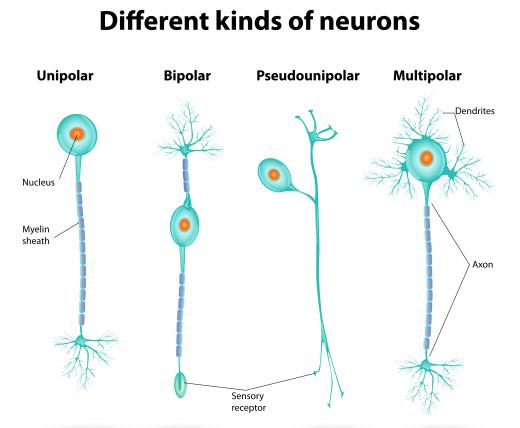In Neuroscience, What Is an Absolute Threshold?
The nervous systems of humans process sensory information by interpreting external and internal stimuli and transferring the information to the brain for processing. Neurons in the brain receive electrochemical impulses. Like any type of sensory instrument, the various afferent, or receptor, neurons have a minimum stimulus that they can actually detect. This stimulus, called the absolute threshold, varies between people and can be affected by external conditions. When individuals are tested, they may or may not experience the stimulus; therefore, the absolute threshold is defined as the lowest detectable level of a stimulus 50% of the time.
Vision relies on two types of cells, rods and cones, which have different functions. Cones detect color; rods detect shapes and are best suited for seeing in darkness. The absolute threshold for vision, or the minimum number of photons that the eye can detect, is generally accepted as 90 photons, only nine of which reach the retina and fovea, the most sensitive part of the eye. This measurement assumes optimal conditions; i.e., eyes completely adjusted to darkness and a wavelength to which the rod cells are most sensitive.

Hearing works by transmitting electrochemical impulses through the auditory nerve when air vibrations transfer from the eardrum to the cilia in the inner ear. The minimum atmospheric pressure to induce audible sound when the source is adjacent to the ear is 20 micropascals, assuming no hearing damage. The ear is intended to hear sounds within the range of 20 to 20,000 hertz, but is most sensitive when exposed to frequencies between 1,000 and 5,000 hertz.

Several factors can influence a person's reported absolute threshold: expectation or anticipation of the stimulus, repeated exposure, damage to the sensory organs, and mental or emotional state. If a person is expecting to receive a particular stimulus, he or she will be naturally more attuned to it. Repeated exposure, on the other hand, will cause the sensory nervous system to filter out that type of input. Sensory organ damage increases the absolute threshold, and high stress levels will cause the body to secrete adrenaline, which makes the sensory organs more attuned to incoming stimuli and likely to respond.

Absolute threshold is distinguished from difference threshold. This measurement refers to the minimum difference between two or more stimuli required for the brain to detect any difference. The body's difference threshold can be trained; for example, wine tasters learn to distinguish between nearly identical flavors of wine.
AS FEATURED ON:
AS FEATURED ON:














Discuss this Article
Post your comments